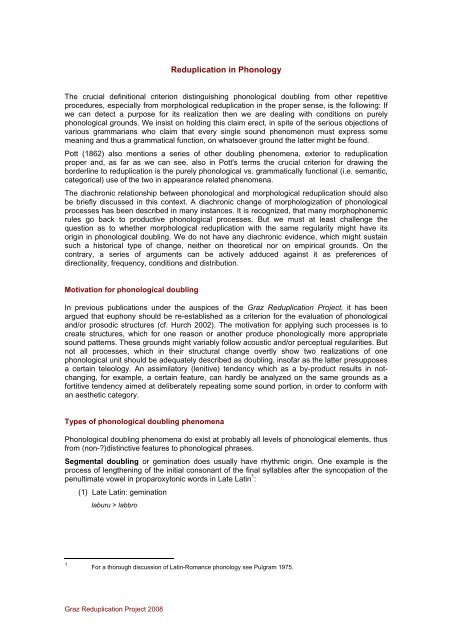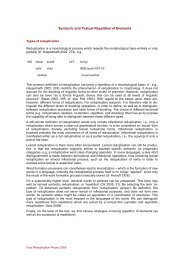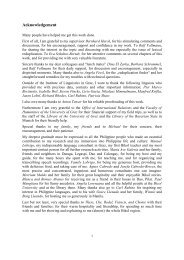Reduplication in Phonology - Reduplication Graz
Reduplication in Phonology - Reduplication Graz
Reduplication in Phonology - Reduplication Graz
Create successful ePaper yourself
Turn your PDF publications into a flip-book with our unique Google optimized e-Paper software.
<strong>Reduplication</strong> <strong>in</strong> <strong>Phonology</strong><br />
The crucial def<strong>in</strong>itional criterion dist<strong>in</strong>guish<strong>in</strong>g phonological doubl<strong>in</strong>g from other repetitive<br />
procedures, especially from morphological reduplication <strong>in</strong> the proper sense, is the follow<strong>in</strong>g: If<br />
we can detect a purpose for its realization then we are deal<strong>in</strong>g with conditions on purely<br />
phonological grounds. We <strong>in</strong>sist on hold<strong>in</strong>g this claim erect, <strong>in</strong> spite of the serious objections of<br />
various grammarians who claim that every s<strong>in</strong>gle sound phenomenon must express some<br />
mean<strong>in</strong>g and thus a grammatical function, on whatsoever ground the latter might be found.<br />
Pott (1862) also mentions a series of other doubl<strong>in</strong>g phenomena, exterior to reduplication<br />
proper and, as far as we can see, also <strong>in</strong> Pott's terms the crucial criterion for draw<strong>in</strong>g the<br />
borderl<strong>in</strong>e to reduplication is the purely phonological vs. grammatically functional (i.e. semantic,<br />
categorical) use of the two <strong>in</strong> appearance related phenomena.<br />
The diachronic relationship between phonological and morphological reduplication should also<br />
be briefly discussed <strong>in</strong> this context. A diachronic change of morphologization of phonological<br />
processes has been described <strong>in</strong> many <strong>in</strong>stances. It is recognized, that many morphophonemic<br />
rules go back to productive phonological processes. But we must at least challenge the<br />
question as to whether morphological reduplication with the same regularity might have its<br />
orig<strong>in</strong> <strong>in</strong> phonological doubl<strong>in</strong>g. We do not have any diachronic evidence, which might susta<strong>in</strong><br />
such a historical type of change, neither on theoretical nor on empirical grounds. On the<br />
contrary, a series of arguments can be actively adduced aga<strong>in</strong>st it as preferences of<br />
directionality, frequency, conditions and distribution.<br />
Motivation for phonological doubl<strong>in</strong>g<br />
In previous publications under the auspices of the <strong>Graz</strong> <strong>Reduplication</strong> Project, it has been<br />
argued that euphony should be re-established as a criterion for the evaluation of phonological<br />
and/or prosodic structures (cf. Hurch 2002). The motivation for apply<strong>in</strong>g such processes is to<br />
create structures, which for one reason or another produce phonologically more appropriate<br />
sound patterns. These grounds might variably follow acoustic and/or perceptual regularities. But<br />
not all processes, which <strong>in</strong> their structural change overtly show two realizations of one<br />
phonological unit should be adequately described as doubl<strong>in</strong>g, <strong>in</strong>sofar as the latter presupposes<br />
a certa<strong>in</strong> teleology. An assimilatory (lenitive) tendency which as a by-product results <strong>in</strong> notchang<strong>in</strong>g,<br />
for example, a certa<strong>in</strong> feature, can hardly be analyzed on the same grounds as a<br />
fortitive tendency aimed at deliberately repeat<strong>in</strong>g some sound portion, <strong>in</strong> order to conform with<br />
an aesthetic category.<br />
Types of phonological doubl<strong>in</strong>g phenomena<br />
Phonological doubl<strong>in</strong>g phenomena do exist at probably all levels of phonological elements, thus<br />
from (non-?)dist<strong>in</strong>ctive features to phonological phrases.<br />
Segmental doubl<strong>in</strong>g or gem<strong>in</strong>ation does usually have rhythmic orig<strong>in</strong>. One example is the<br />
process of lengthen<strong>in</strong>g of the <strong>in</strong>itial consonant of the f<strong>in</strong>al syllables after the syncopation of the<br />
penultimate vowel <strong>in</strong> proparoxytonic words <strong>in</strong> Late Lat<strong>in</strong> 1 :<br />
(1) Late Lat<strong>in</strong>: gem<strong>in</strong>ation<br />
laburu > labbro<br />
1<br />
For a thorough discussion of Lat<strong>in</strong>-Romance phonology see Pulgram 1975.<br />
<strong>Graz</strong> <strong>Reduplication</strong> Project 2008
Other <strong>Reduplication</strong> Phenomena<br />
The rhythmic orig<strong>in</strong> of such gem<strong>in</strong>ations can properly be understood by exam<strong>in</strong><strong>in</strong>g the opposite<br />
tendency of simplification, cf. the Late Lat<strong>in</strong> “Lex Mamilla”:<br />
(2) Late Lat<strong>in</strong>: simplification<br />
mamma ‘breast’ > mamilla dim<strong>in</strong>utive<br />
Doubl<strong>in</strong>g of portions of the syllable is well known <strong>in</strong> (poetic) rhym<strong>in</strong>g, which is ideally based<br />
on the identity and repetition of that part of the syllable which <strong>in</strong>cludes the nucleus and the<br />
follow<strong>in</strong>g material up to the boundary. Use and type of rhym<strong>in</strong>g are mostly governed by stylistic<br />
pr<strong>in</strong>ciples.<br />
Doubl<strong>in</strong>g of syllables has, for example, been described for Tarahumara. In so-called<br />
‘expletive’ reduplication <strong>in</strong> Tarahumara (cf. Brambilla 1953: 8), any f<strong>in</strong>al syllable can be echoed<br />
with the sequence k plus the f<strong>in</strong>al vowel, whenever the f<strong>in</strong>al syllable is accented, with<br />
preferences accord<strong>in</strong>g to certa<strong>in</strong> <strong>in</strong>tonational position.<br />
(3) Tarahumara (Uto-Aztecan, Mexico)<br />
a. txopé > txopeke 'p<strong>in</strong>e firewood'<br />
b. pačí > pačiki ‘corn cob’ (cf. Brambila 1953: 8)<br />
c. sonó > sonoko ‘stubble (field)’ (ibid.)<br />
Doubl<strong>in</strong>g of rhythmic patterns is used <strong>in</strong> poetry and it is familiar under the term 'meter': The<br />
pre-stabilized sequence of a certa<strong>in</strong> number of feet with a fixed <strong>in</strong>ternal and overall structure is<br />
regularly repeated <strong>in</strong> order to create cohesion <strong>in</strong> the text. Poetic meter is also governed by<br />
stylistics.<br />
These phonological doubl<strong>in</strong>g processes can be viewed as salient <strong>in</strong> human perception. The<br />
possibilities and regularities of doubl<strong>in</strong>g must be regulated more specifically by what is<br />
perceived as rhythmically 'better', as be<strong>in</strong>g more pleasant, as a higher euphony, as a stylistic<br />
means of verbal art, or as a stylistic figure (both the latter <strong>in</strong> poetry).<br />
References<br />
Brambila, David. 1953. Gramática Raramuri. Mexico: Editorial Buena Prensa.<br />
Hurch, Bernhard. 2002. 'Die sogenannte expletive Reduplikation im Tarahumara. Zur Rehabilitation e<strong>in</strong>es<br />
verpönten Begriffs: Euphonie'. In Michael Bommes, Christ<strong>in</strong>e Noack and Doris Toph<strong>in</strong>ke (eds.)<br />
Sprache als Form. Festschrift für Utz Maas zum 60. Geburtstag. Wiesbaden: Westdeutscher Verlag.<br />
Pott, August Friedrich. 1862. Doppelung (Reduplikation, Gem<strong>in</strong>ation) als e<strong>in</strong>es der wichtigsten<br />
Bildungsmittel der Sprache, beleuchtet aus Sprachen aller Welttheile. Lemgo & Detmold: Meyer.<br />
Pulgram, Ernst. 1975. Lat<strong>in</strong>-Romance <strong>Phonology</strong>: Prosodics and Metrics. München: Wilhelm F<strong>in</strong>k Verlag.<br />
htpp://reduplication.uni-graz.at/ 2





